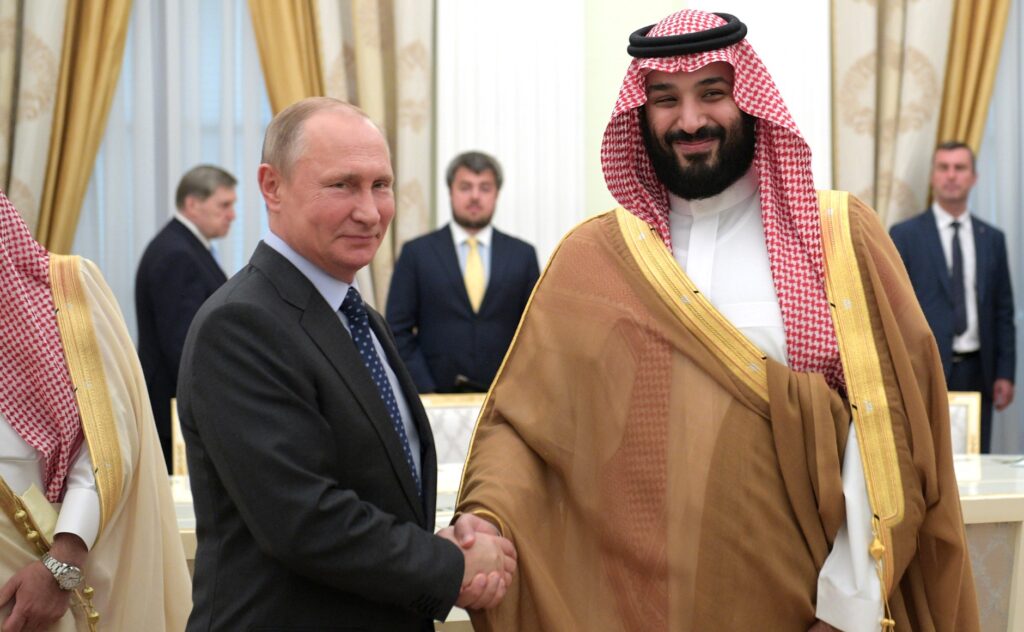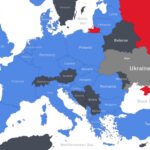
English: Vladimir Putin met with Crown Prince and Defence Minister of Saudi Arabia Mohammad bin Salman Al Saud. June 14, 2018. Photo courtesy of the office of the President of Russia.
Vladimir Putin’s Russia has been working hand in hand with OPEC+ for years to keep oil prices high, but now Russia is pumping as much oil as it can to fund its war in Ukraine, and Saudi Arabia and the other members of OPEC+ are not happy. In The Spectator, Damien Phillips suggests Putin is “killing the OPEC golden goose.” He writes:
As Russia frantically attempts to hold on to its territorial gains in the face of the much-anticipated Ukrainian counteroffensive, there are early signs that it is also failing to retain its diplomatic and foreign policy advances. The anti-Western energy alliances it had constructed around the world with many of the leading oil and gas producers, which had endured despite the invasion, are beginning to fracture. Its attempts to shutdown competitors to Russian oil and gas have proved futile.
It all went wrong so quickly for Russia. Back in 2016, the Organization of Petroleum Exporting Countries (OPEC) expanded to include Russia as part of OPEC+. The deal, painstakingly brokered by Saudi Arabia, was seen as a personal victory for de facto ruler Crown Prince Mohammed bin Salman (MbS). There was much talk of a “a new oil bromance” between MbS and Vladimir Putin.
After Russian tanks began rolling into Ukraine, OPEC+ has seemed totally in hoc to Russian policy priorities. With the Western world suffering under an economic crisis partially caused by spiking energy costs — and Putin’s regime dependent on high oil prices to fund its war effort — OPEC+ has repeatedly sided with Russia. It has done so by intervening to push oil prices higher through agreeing to significant cuts in production among its twenty-four members.
Yet at last week’s OPEC+ meeting, tensions began to emerge. Saudi officials have reportedly been growing increasingly annoyed that, rather than cut its oil output by 500,000 barrels a day as agreed at an OPEC+ meeting in April, Russia was instead flooding the market with discounted oil to fund its struggling economy and the “special military operation” it is steadily losing.
Russia’s goal, it seems, is to get OPEC members to push oil prices as high as possible so it can undercut them all below the capped level at which it is officially allowed to sell oil due to G7 restrictions. That strategy appears to be working for now: India and China are gorging on Russian crude at record rates, ignoring Western sanctions, and OPEC’s core members have been losing market share.
But this is a dangerous game for Russia. Its oil is expensive to produce and the supply glut it is creating is pushing down global oil prices, which at the weekend sunk below $70 a barrel. It could eventually see Russia selling oil at a significant loss, harming its ability to fund future military operations.
Crucially, such a short term and underhand approach is eroding confidence within OPEC+. Reports from the latest OPEC+ meeting in Vienna allege that the Saudi energy minister was “fed up with OPEC members not meeting oil output goals” and that he was seeking “more oil output transparency from Russia.” Translation: we don’t trust you anymore.
The potential long-term consequences for Putin of flagrantly double-crossing the world’s second largest oil producer could be dire. The precedent Russia is setting for a free-for-all within OPEC+, where several members including the United Arab Emirates are keen to increase production, may implode the very energy alliance that has so far been beneficial for it.
Read more here.
If you’re willing to fight for Main Street America, click here to sign up for the Richardcyoung.com free weekly email.





